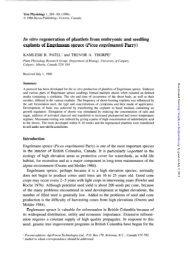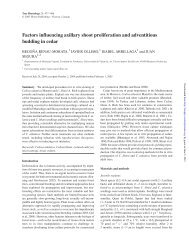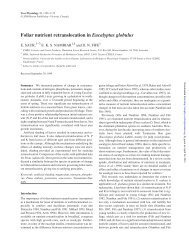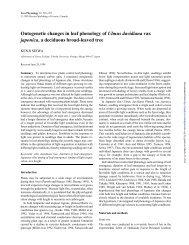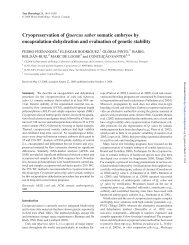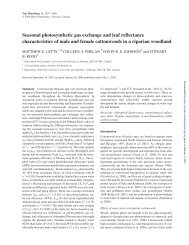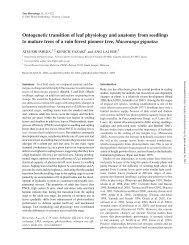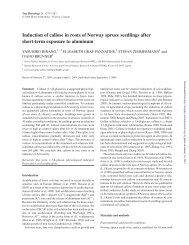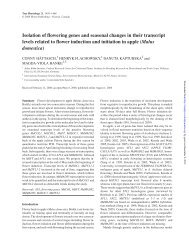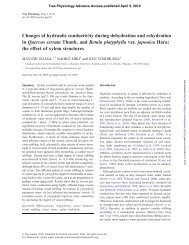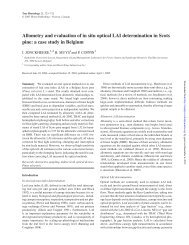Sucrose (JrSUT1) and hexose (JrHT1 and JrHT2 ... - Tree Physiology
Sucrose (JrSUT1) and hexose (JrHT1 and JrHT2 ... - Tree Physiology
Sucrose (JrSUT1) and hexose (JrHT1 and JrHT2 ... - Tree Physiology
You also want an ePaper? Increase the reach of your titles
YUMPU automatically turns print PDFs into web optimized ePapers that Google loves.
SUCROSE AND HEXOSE TRANSPORTERS IN WALNUT XYLEM PARENCHYMA 221<br />
(Figure 3A), <strong>and</strong> the highest identity (85%) was with RcSCP<br />
(Weig et al. 1994). <strong>JrHT1</strong> <strong>and</strong> <strong>JrHT2</strong> had all the characteristics<br />
of monosaccharide transporters including 12 transmembrane-spanning<br />
domains <strong>and</strong> the conserved V/ LPETK or<br />
Table 1. Capacities of buds of apical <strong>and</strong> basal stem segments of<br />
1-year-old walnut stems to import sucrose <strong>and</strong> glucose during bud<br />
break. Values are means ± SE of at least five replicates.<br />
Stem segment <strong>Sucrose</strong> import Glucose import<br />
(nmol g DM –1 h –1 ) (nmol g DM –1 h –1 )<br />
Apical 1453.5 ± 217.8 18.7 ± 8.1<br />
Basal 103.7 ± 23.9 1.4 ± 0.4<br />
TREE PHYSIOLOGY ONLINE at http://heronpublishing.com<br />
Figure 6. Transverse sections showing the<br />
general distribution of <strong>JrSUT1</strong> <strong>and</strong> <strong>JrHT1</strong><br />
<strong>and</strong> <strong>JrHT2</strong> in the xylem parenchyma cells<br />
of walnut stem. Immunolabeling of<br />
<strong>JrSUT1</strong> in living cells of the (A) apical<br />
<strong>and</strong> (C) basal stem segments <strong>and</strong><br />
immunolabeling of <strong>JrHT1</strong> <strong>and</strong> <strong>JrHT2</strong> in<br />
living cells of the (E) apical <strong>and</strong> (G) basal<br />
stem segments. No labeling was detected<br />
in the controls (B, D, F, H). Abbreviations:<br />
A, axial parenchyma cell; F, fiber; R, ray<br />
parenchyma cell; V, vessel; <strong>and</strong> VAC, vessel<br />
associated cell. Scale bars equal<br />
25 µm.<br />
(R/K)XGR(R/K) motifs, <strong>and</strong> <strong>JrHT1</strong> <strong>and</strong> <strong>JrHT2</strong> transcripts<br />
were found in both source <strong>and</strong> sink organs, as is the case for<br />
other <strong>hexose</strong> or monosaccharide transporters (e.g., LeHT2,<br />
Gear et al. 2000; AtSTP4, Trüernit et al. 1996; or PaMST1,<br />
Nehls et al. 2000).<br />
During early spring, walnut xylem sap is considered the primary<br />
route by which soluble sugars are transported from exporting<br />
organs to recipient sinks, mainly the buds <strong>and</strong> possibly<br />
the cambium (Lacointe et al. 2001, 2004). This was verified by<br />
our experiments, which showed a large amount of radiolabeled<br />
sugar, perfused into xylem vessels, moved to vegetative bud<br />
cells (Table 1). At bud burst, bud vascular tissue includes only<br />
protoxylem, so that, to reach the meristematic zone, sugars<br />
must pass by the VACs, which control nutrient exchanges between<br />
xylem vessels <strong>and</strong> parenchyma cells (Fromard et al.<br />
Downloaded from<br />
http://treephys.oxfordjournals.org/ by guest on December 27, 2012



